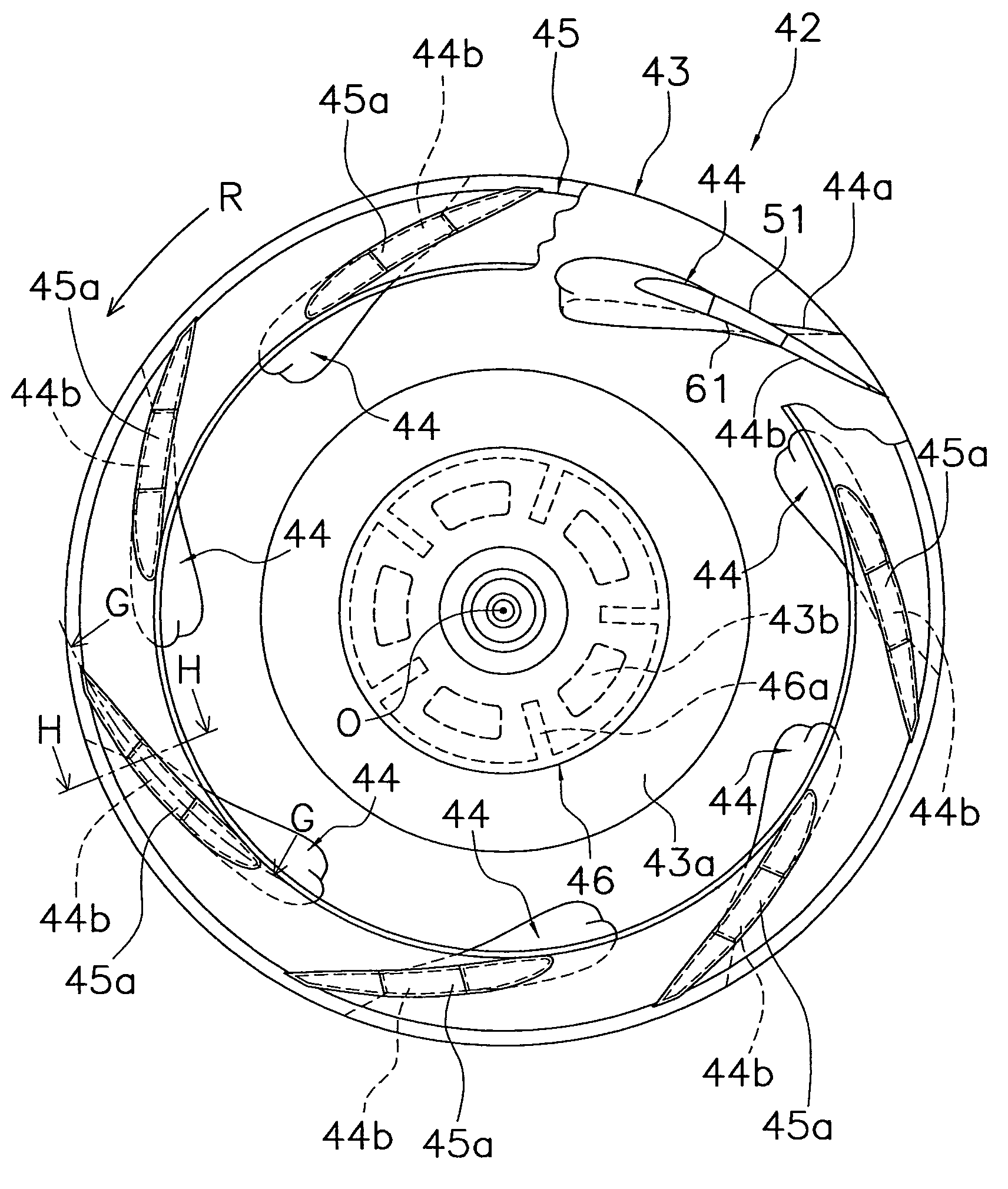Impeller of centrifugal fan and centrifugal fan disposed with the impeller
a technology of centrifugal fans and impellers, which is applied in the direction of blade accessories, machines/engines, waterborne vessels, etc., can solve the problems of difficult drawbacks such as squeaking and wind roar, and achieve the effects of preventing deformation of hollow blades, reducing weight of impellers, and improving blowing performance and noise performan
- Summary
- Abstract
- Description
- Claims
- Application Information
AI Technical Summary
Benefits of technology
Problems solved by technology
Method used
Image
Examples
modified examples 1 to 3
[0131]As shown in FIG. 7, each of the blades 44 in the preceding embodiment is divided such that the blade cover 61 configures the portion of the negative-pressure surface 44f excluding the rear edge portion serving as part of the blade 44 and such that the blade body 51 configures the positive-pressure surface 44e and the rear edge portion of the negative-pressure surface 44f. However, each of the blades 44 may also have the following divided structure between the blade cover 61 and the blade body 51 in order to promote the hollowing of the blade 44 and prevent drawbacks such as squeaking and wind roar.
[0132]For example, as shown in FIG. 15 (a view showing a blade according to Modified Example 1, corresponding to FIG. 7), the blade 44 may be divided such that the blade body 51 configures not only the rear edge portion of the negative-pressure surface 44f but also the front edge portion of the negative-pressure surface 44f, and such that the blade cover 61 configures the negative-pr...
modified example 4
[0136]In the preceding embodiments, hollowing was promoted by giving each of the blades 44 a divided structure between the blade body 51 and the blade cover 61, the blade body 51 was fixed to the end plate 43 and the end ring 45 molded separately from the blade body 51, and the blade cover 61 configuring at least part of the negative-pressure surface 44f of the blade 44 was attached to the blade body 51 by fitting it into the blade body 51, whereby the impeller 42 was configured where it is difficult for drawbacks such as squeaking and wind roar to occur.
[0137]However, the blade bodies 51 and the end plate 43 and the end ring 45 do not always have to be separate members in order to promote the hollowing of the blades 44 and prevent drawbacks such as squeaking and wind roar.
[0138]For example, the blade bodies 51 and the end plate 43 may be integrally molded and the end ring 45 may be molded as a separate member. By configuring the invention in this manner, the blade covers 61 are att...
modified example 5
[0141]In the preceding embodiments, because the blade cover 61 configuring the majority of the negative-pressure surface 44f of each of the blades 44 was a member separate from the blade body 51 and the end plate 43 and the end ring 45, there were few restrictions in direction in which it is removed from the mold when it is molded, and a concavo-convex shape could be easily formed in the surface of the blade cover 61. Also, when the blade body 51 is molded separately from the end plate 43 and the end ring 45, a concavo-convex shape can also be easily formed in the surface of the blade body 51.
[0142]For example, as shown in FIG. 18 (a view showing a blade according to Modified Example 5, corresponding to FIG. 5) and FIG. 19 (a view showing a blade according to Modified Example 5, corresponding to FIG. 5), plural dimples 51a and 61a can be formed in the surfaces of the blade body 51 and the blade cover 61.
[0143]By disposing the plural dimples 51a and 61a in the surfaces of the blade b...
PUM
| Property | Measurement | Unit |
|---|---|---|
| pressure | aaaaa | aaaaa |
| centrifugal force | aaaaa | aaaaa |
| length | aaaaa | aaaaa |
Abstract
Description
Claims
Application Information
 Login to View More
Login to View More - R&D
- Intellectual Property
- Life Sciences
- Materials
- Tech Scout
- Unparalleled Data Quality
- Higher Quality Content
- 60% Fewer Hallucinations
Browse by: Latest US Patents, China's latest patents, Technical Efficacy Thesaurus, Application Domain, Technology Topic, Popular Technical Reports.
© 2025 PatSnap. All rights reserved.Legal|Privacy policy|Modern Slavery Act Transparency Statement|Sitemap|About US| Contact US: help@patsnap.com



